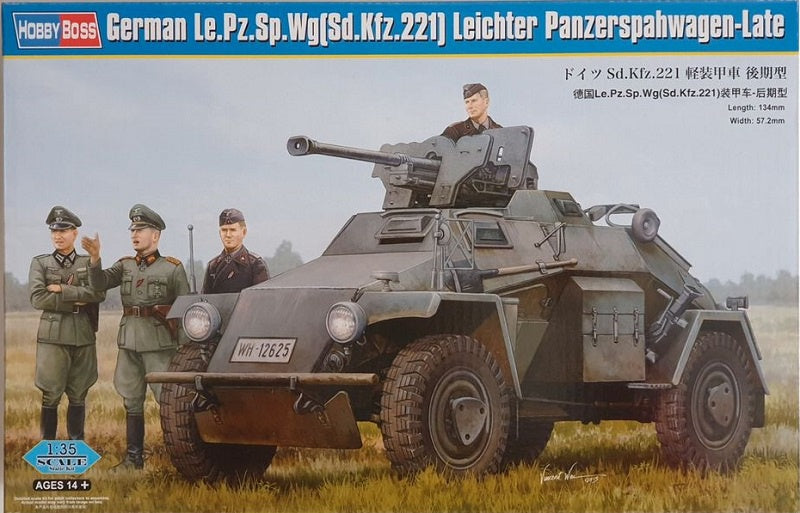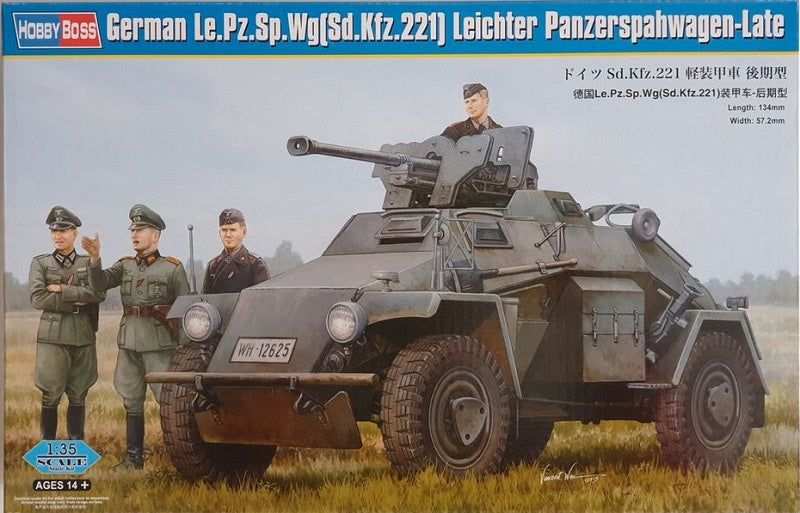HB 1:35 Le.Pz.Sp.Wg (Sd.Kfz.221) Leichter Panzerspahwagen-Late
HB 1:35 Le.Pz.Sp.Wg (Sd.Kfz.221) Leichter Panzerspahwagen-Late is backordered and will ship as soon as it is back in stock.
Couldn't load pickup availability
Delivery and Shipping
Delivery and Shipping
We use tracked courier for fast delivery New Zealand wide
Description
Description
The Leichter Panzerspähwagen (German: "light armoured reconnaissance vehicle") was a series of light four-wheel drive armoured cars produced by Nazi Germany from 1935 to 1944.
The Sd.Kfz. 221 was the first in a series of light reconnaissance vehicles designed to meet operational requirements including reliability, an ability to run on a variety of grades of fuel, simple construction and good off-road performance. However, this type proved too small and too lightly armed, so in 1936-37 a heavier version was planned, using one of two standard chassis for four-wheeled armoured cars - one with a front-mounted engine, the other rear-mounted. The latter was used in the Sd.Kfz. 222, which then became the standard light armoured car in German army service until the defeat of Nazi Germany.
The vehicles were developed by Eisenwerk Weserhütte of Bad Oeynhausen by using the chassis of the type Horch 108 (one of the Einheits-PKW der Wehrmacht standardised designs of heavy off-road car for the armed forces) with an angled armoured body and turret.
Chassis were built by Horch (Auto Union) in Zwickau and assembled by F. Schichau of Elbing and Maschinenfabrik Niedersachsen in Hanover-Linden.
The rear-mounted petrol engine was originally a 3.5 Litre Horch V8 with 75 PS (55 kW; 74 hp) (Ausf. A chassis); from 1942, this was replaced by a 3.8 Litre with 90 PS (66 kW; 89 hp) (Ausf. B chassis), giving it a road speed of 80 km/h (50 mph) and a cross-country speed of 40 km/h (25 mph). It had a maximum range of 300 km (186 mi).
Used by the reconnaissance battalions (Aufklärungs-Abteilung) of the Panzer divisions, the type performed well enough in countries with good road networks, like those in Western Europe. However, on the Eastern Front and in the deserts of the North African campaign, this class of vehicle was hampered by its relatively poor off-road performance.
The Sd.Kfz. 222 was fitted with heavier armament and a larger turret than the Sd.Kfz. 221 but it was still comparatively cramped and lacked top protection other than a wire screen designed to allow grenades to roll off, but this made using the main armament problematic. The machine gun was mounted co-axially with the autocannon, and both weapons were pintle-mounted, and fitted with an elevation and traverse mechanism and floor-mounted firing mechanisms. The turret was rotated by the traversing weapons rather than the weapons being fixed to a traversing turret. There was thus no bearing-ring and no turret basket, only a fighting compartment largely obstructed by the breeches of the weapons.
1:35 scale plastic assembly kit.
Requires glue and paints to complete.
Payment & Security
Payment methods
Your payment information is processed securely. We do not store credit card details nor have access to your credit card information.




